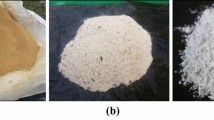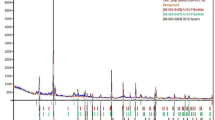Abstract
In clayey lands, swelling problem causes vertical displacements on road subbase, and finally, failure in pavement occurs due to lack of appropriate drainage systems. One popular and inexpensive method of soil stabilization is using lime. Investigations indicate that based on environmental and atmospheric conditions, the chemical reaction of lime and clayey soil is not accomplished well, owning to low temperature and high humidity. This paper aims to investigate the influence of adding rice husk ash on the reaction between soil and lime and lime reaction and determine soil physical and mechanical characteristics. Therefore, sufficient laboratory soil tests, such as Atterberg limits, compaction, California bearing ratio (CBR), and direct shear test are carried out, and the results are analyzed. The results generally indicate that adding lime and rice husk ash (RHA) causes a decrease in dry density and an increase in optimum water content. Increasing lime and RHA causes a decreasing rate in soil liquid limit and plastic limit. Adding lime and RHA to the soil causes a decrease in deformability of soil samples and gives more brittle materials. Also, this action causes an increase in shear strength. Moreover, increasing in CBR amount under the influence of increasing RHA is one of the main results of this paper.
Similar content being viewed by others
References
Alhassan M (2008). Permeability of lateritic soil treated with lime and rice husk ash. Assumption University Journal of Thailand, 12(2): 115–120
Ali F H, Adnan A, Choy C K (1992). Geotechnical properties of a chemically stabilized soil from Malaysia with rice husk ash as an additive. Geotechnical and Geological Engineering Journal, 10(2): 117–134
American Association of State Highway and Transportation Officials (AASHTO) (1986). Standard Specifications for Classification of Soils and Soil-Aggregate Mixtures for Highway Construction Purposes (M145). Washington D C, USA
American Society for Testing and Material (ASTM) (2002). Test Methods for Laboratory Compaction Characteristics of Soil Using Standard Effort (D0698-07E01). Annual Books of ASTM Standard, Section 4 Vol. 0408 USA
American Society for Testing and Material (ASTM) (2002). Test Methods for Liquid Limit, Plastic Limit, and Plasticity Index of Soils (D4318-05). Annual Books of ASTM Standard, Section 4 Vol. 0408 USA
American Society for Testing and Material (ASTM) (2002). Test Methods for Direct Shear Test of Soils under Consolidated Drained Conditions (D3080-04). Annual Books of ASTM Standard, Section 4 Vol. 0408 USA
American Society for Testing and Material (ASTM) (2002). Test Methods for Expansion Index of Soils (D4829-08A). Annual Books of ASTM Standard, Section 4 Vol. 0408 USA
American Society for Testing and Material (ASTM) (2002). Test Methods for CBR (California Bearing Ratio) of Laboratory-Compacted Soils (D1883-07). Annual Books of ASTM Standard, Section 4 Vol. 0408 USA
Balasubramaniam A S, Lin D G, Acharya S S S, Kamruzzaman A H M (1999). Behavior of soft Bangkok clay treated with additives. The 11th Asian Regional Conference on Soil Mechanic and Geotechnical Engineering, Seoul, 1: 11–14
Basha E A, Hashim R, Mahmud H B, Muntohar A S (2005). Stabilization of residual soil with rice husk ash and cement. Journal of Construction and Building Materials, 19(6): 448–453
Chang Y, Shao C, Yi-Guang W (2009). On the enhancement of electroosmotic soil improvement by the injection of saline solutions. Journal of Applied Clay Science, 44(1–2): 130–136
Jha J N, Gill K G (2006). Effect of rice husk ash on lime stabilization. Journal of the Institution of Engineers (India), 87: 33–39
Ladd C C, Moh Z C, Lambe T W (1960). Recent Soil—Lime Research At The Massachusetts Institute Of Technology. 39th Annual Meeting, Highway Research Board. Washington D C, USA, 64–84
Lazaro R C, Moh Z C (1970). Stabilization of deltaic clays with lime-rice husk ash admixtures. The 2nd Southeast Asian Conference on Soil Engineering, Singapore, 215–223
Marks B D, Haliburton T A (1970). Effect Of Sodium Chloride And Sodium Chloride—Lime Admixtures On Cohesive Oklahoma Soils. 49th Annual Meeting of the Highway Research Board,Washington DC, USA
Mehta P K (1992). Rice Husk Ash—A Unique Supplementary Cementing Material. Proceedings of the International Symposium on Advances in Concrete Technology, Athens, Greece, 407–430
Muntohar A S (2004). Uses of RHA to Enhanced Lime-Stabilized Clay Soil. International Conference of Geotechnical Engineering, University of Sharjah, United Arab Emirate
Muntohar A S, Hantoro G (2000). Influence of the rice husk ash and lime on engineering properties of clayey subgrade. Electronic Journal of Geotechnical Engineering, 5: 1–19
Muntohar A S, Hashim R (2002) Silica Waste Utilisation In Ground Improvement: A Study Of Expansive Clay Treated With LRHA. The 4th International Conference on Environmental Geotechnics, Rio de Janeiro, 1: 515–519
Mustapha A M, Alhassan M (2005). Effect of Bagasse ash on cement stabilized laterite. Seminar presented in the Department of Civil Engineering, Ahmadu Bello University, Zaria, Nigeria
Mylavarapu R S, Zinati G M (2009). Improvement of soil properties using compost for optimum parsley production in sandy soils. Journal of Scientia Horticulturae, 120(3): 426–430
Nair D G, Fraaij A, Klaassen A K, Kentgens P M (2008). A structural investigation relating to the pozzolanic activity of rice husk ashes. Journal of Cement and Concrete Research, 38(6): 861–869
Neville A M (2000). Properties of Concrete. 4th ed. Pearson Education Asia Ltd., Kuala Lumpur, Malaysia
Noor M, Abdol Aziz A, Suhadi R (1990). Effects of cement rice husk ash mixtures on compaction, strength and durability of Melaka Series lateritic soil. Journal of Institution of Engineers Malaysia, 47: 61–64
O’Flaherty C A (1974). Highway Engineering, Vol. 2. London: Edward Arnold
Ola S A (1983). Permeability of some compacted Nigerian soils. Balkema, the Netherlands, 155–171
Osinubi K J (1998). Permeability of lime-treated lateritic soil. Transp Engrg J, 124(5): 465–469
Osula D O A (1991). Lime modification of problem laterite. Journal of Engineering Geology, 30(2): 141–154
Oyetola E B, Abdullahi M (2006). The use of rice husk ash in low-cost sandcrete block production. Leonardo Electronic Journal of Practice and Technology, 5(8): 58–70
Rahman M A (1987). Effect of cement—rice husk ash mixtures on geotechnical properties of lateritic soils. Journal of Soils and Foundations, 27(2): 61–65
Rogers C D F, Glendinning S (1997). Improvement of clay soils in situ using lime piles in the UK. Journal of Engineering Geology, 47(3): 243–257
Author information
Authors and Affiliations
Corresponding author
Rights and permissions
About this article
Cite this article
Choobbasti, A.J., Ghodrat, H., Vahdatirad, M.J. et al. Influence of using rice husk ash in soil stabilization method with lime. Front. Earth Sci. China 4, 471–480 (2010). https://doi.org/10.1007/s11707-010-0138-x
Received:
Accepted:
Published:
Issue Date:
DOI: https://doi.org/10.1007/s11707-010-0138-x




